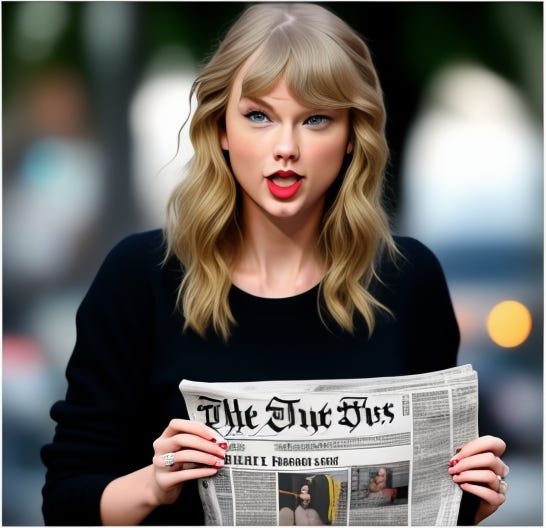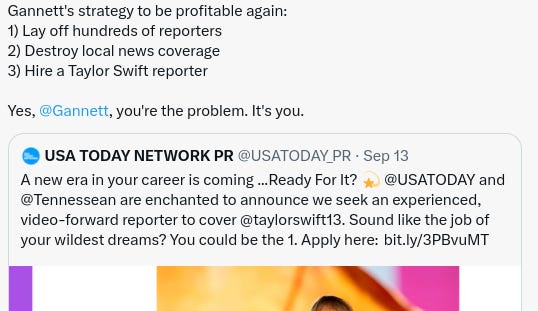A new journalism job just dropped and some journalists are mad about it.
USA Today and The Tennessean announced this week that they’ll hire a full-time reporter to cover the pop megastar Taylor Swift, whose Eras Tour is producing such a large impact that it can literally be observed in the economic data tracked by the Federal Reserve.
What’s next, a Beyoncé reporter? Actually, yes. Gannett — which runs USA Today and The Tennessean — is hiring for the Beyoncé beat too.

A slightly terrifying cropped version of an AI-generated prompt for “taylor swift newspaper reporter”. Via Stable Diffusion.
Rest assured, Silver Bulletin readers: I’m not applying for these jobs myself.1 Still, it doesn’t seem hard to understand why news organizations would devote coverage to stars with the wattage of Swift or Beyoncé — in exactly the same way that ESPN once hired the journalist Brian Windhorst to essentially be a full-time LeBron James reporter.
And yet, the job opening provoked a lot of smarmy reactions from journalists on X/Twitter. I don’t want to call out any account by name, because I understand where the sentiment is coming from given the crappy-as-usual conditions in the industry. So I’ve redacted the username here. Still, there were a lot of variations on this theme:

The idea here isn’t complicated. Gannett fired a lot of local news reporters. Now, they’re hiring a Taylor Swift reporter. Why are they doing that? Well, now that I’ve outed myself as a neoliberal shill, I can tell you exactly why: It’s probably because they think they were losing money on those local news reporters and think they’ll make money from the Taylor Swift reporter.
Look, I get it, the decline of local news coverage really sucks. I grew up with a Gannett paper, the Lansing State Journal, and I know the reporters that remain there must be doing a great job. But when I make it home, the paper is literally just kind of a gutted, much thinner version of its former self. I am not here to propose a solution to the local news crisis.
What I do know is that a Taylor Swift reporter almost certainly won’t make the crisis worse, and just might make it better at the margin.
What’s the most successful American newspaper brand right now? It is pretty clearly The New York Times. Conflicting biases: I formerly worked there, but I’ve also criticized the Times a lot. However, this isn’t a particularly close call. The Times is far and away the largest U.S. news outlet for combined digital and print subscribers. While The Washington Post or The Wall Street Journal compete with it effectively on some beats, no other publication has its reach or breadth. And just as importantly for purposes of this conversation, the Times is doing a pretty decent job of actually turning a profit.
So let’s ask this: What story — as of when I’m writing this draft on Wednesday late afternoon New York time — is leading the Times’s most-emailed list?
Surely, some deep piece of investigative reporting? Some update from the front lines of Ukraine?
Fuck no.
The leading story is a feel-good treatment of a celebrity wedding. Granted, the celebrity in question (Robin Roberts) is someone I have a ton of respect for, and who brings some gravitas and news value.2 But still, the most popular New York Times story at this moment is literally a wedding story. And most of the other items on its top 10 emailed list aren’t hard news either:
You have another story about marriage further down the list, a story about Apple shifting to USB-C, some well-written arts and leisure pieces, a Michelle Goldberg op-ed, and a service journalism story about food expiration dates. Scroll down a bit further past the top 10, and there are stories about cooking and yoga.
Meanwhile, the only two real news stories, about the FDA approving COVID boosters and a new government report on the poverty rate, aren’t doing anything especially proprietary and were based on government announcements that were widely reported everywhere. Granted, the Times will typically add some value with these stories — they’ll write them more crisply, turn them around more quickly, and reach higher-ranking sources for comment — but we’re not exactly talking about Watergate.
Instead, the New York Times’s strategy is take a whole bunch of exceptionally popular beats that are a long way from muckraking journalism — style, real estate, Wordle, opinion columns and lifestyle stories that flatter their readers’ priors — and bundle them with important but money-losing beats like investigative reporting and foreign coverage. The Times audience is different than the typical one, so its most viral stories might be about Robin Roberts’s wedding and house-hunting in Sag Harbor rather than about Taylor Swift’s concert tour and Aaron Rodgers’s injury. Nonetheless, the strategy — the highly lucrative, highly successful strategy — is to provide plenty of coverage that entertains and delights Times readers, most of which is produced to a very high level of quality, but which isn’t what you’d traditionally think of as “all the news fit to print”.
Now, the Times undoubtedly does benefit from a mostly well-deserved halo effect for institutional quality, such as by having won a lot of Pulitzer Prizes. But look, I’ve actually been a Pulitzer judge and I can tell you that news organizations produce a lot of high-quality “prize bait” stories that are expensive to report out but don’t gain much of an audience. The reputational benefit from an occasional award might get you 20 cents back on the dollar.
So basically the Times is using its version of Taylor Swift beat reporters to subsidize a lot of very important and newsworthy reporting. The economics and internal politics of this are uneasy, because if the Times makes a marginal $1 million a year in profit from covering (say) Hamptons real estate, a lot of people could make a claim to that booty. Not just the other departments in the paper, but also the reporter covering the beat (who could threaten to start a Substack if she doesn’t get a raise) or the Sulzberger family, which could argue for keeping the profit for shareholders.
Still, having an extra $1 million is a good problem to have. If the Times determined only to cover hard news, it would wind up covering much less of it, because it wouldn’t make nearly as much from subscribers and advertisers, and couldn’t afford to staff the same very expensive newsroom.
The situation at Gannett might be different in degree, though probably not in kind. It doesn’t have the same prestige, so its Taylor Swift reporter there might be less willing to accept a salary less than his or her marginal product.3 And corporate management there probably has a shorter-term and more cynical focus and is less likely to reinvest the profits in other areas of coverage. But Taylor Swift didn’t take the local reporting jobs away. She won’t bring most of them back either, but if Swift can have an impact big enough to show up on the Federal Reserve’s radar, the Swiftie beat is at least worth a try.





